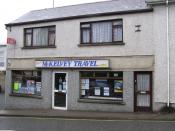According to BNet.com (2007) "with the advent of technological revolution, many organizations are entering into e-business. The evolution of e-business has opened a whole new world of services before people, right from marketing and sales to supply-chain fulfillment" (p. 1). The travel agency is no exception to this revolution. Most travelers would like to have total control over his or her travel arrangements and destination, and feel they are getting the most for their money. The introduction of such sites as Travelocity, Orbitz, and Expedia have created web sites for consumers to do just that.
Brick and Mortar Travel AgencyBrick and mortar, according to Answers.com (2007), "is a traditional street-side business that deals with its customers face to face in an office or store that the business owns or rents" (p. 1). For example, U.S. Travel operates out of several locations throughout the Pacific Northwest. The company's marketing strategy, in the wake of online travel agencies like Expedia.com, caters to a more personable approach acting as travel consultants as opposed to a clients shopping for deals on his or her own via a website (U.S. Travel, 2007, p. 1). In comparison, marketing techniques that have grown out of the internet revolution have used psychological analysis to gain knowledge on what customers appeal to then use the data, design, and graphics to attract customers to specific websites. In fact, according to an article titled E-business Strategies: The Nature of Customer Attention (p. 1):This requires more imaginative thinking for systems design, technology exploitation, and customer receptivity. The essence of this approach is to formulate a deeper recognition of what drives customer motivations to engage in certain attention behavior. A central theme is to develop mechanisms, through e-business electronic media, which focuses their attention on the product or service offered.


